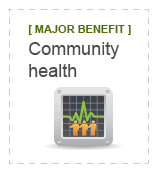Increase active transportation and alternatives to single-occupancy car travel.
Best Practice
Best Practice Actions
a. Document increased infrastructure for pedestrians, bikers, and public transit users.
b. Increase the number of employers promoting multiple commuting options.
c. Be recognized as a Walk Friendly, Bicycle Friendly, or Age Friendly Community.
- Rideshare programs help connect people to travel together to the same or similar destinations. Carsharing is a form of shared vehicle ownership to provide members with vehicles for personal use without the costs and commitment of individual car ownership. (AFDC)
- The Metro Transit Guaranteed Ride Home program helps get alternative transportation (i.e. carpool, bike, walk, transit) users home for FREE in the case of an emergency by taxi, rideshare, carshare, or other transit.
- Climate Strategies that Work (U.S. DOT, 2024) provides actionable information for 27 transportation-related emission reduction strategies (including Micromobility and Ridesharing) through well-vetted guides detailing benefits, implementation steps, and resources.
- Ridesharing:
- Carsharing:
- Evie Community Carshare is an all-electric, free floating carshare service with over 170 vehicles throughout the Twin Cities.
- HourCar is a non-profit carsharing service in Minneapolis, St. Paul, and Rochester with fixed sites to pick-up cars.
- Use MnDOT's Shared Mobility Public-Private Partnership Guide to promote the growth of innovative shared mobility options in your community.
- Find resources from CoMoUK for supporting shared car services (or what they call, "car clubs") through policy, development design, installing EV charging, and more.
- Consider how to encourage equitable shared mobility.
- Bike/Scooter Sharing:
- Many public-share bike and scooter options like Lime, Lyft, Spin, etc. are available in Minnesota.
- Recent research indicates that people interested in electric bikes and electric scooters tend to use them to replace car trips, not manual bike trips.
- A city or municipal utility might provide their own e-bike rebate program, like Edina’s Community Climate Action Fund does.
- For help in managing new mobility data from electric scooter companies, transportation network companies, and the like, see guidance from The National Association of City Transportation Officials.
- Integrating Bike Share Programs into a Sustainable Transportation System (National League of Cities, 2011) highlights successful bike share programs from Denver, Colo., Washington DC, Minneapolis, and Buffalo, New York.
- The Bike-Share Planning Guide (Institute for Transportation & Development Policy, 2018) focuses on the five top factors that determine whether a bike-share system thrives: station density, bikes per resident, coverage area, quality of bikes, and easy-to-use interfaces for checking out and paying for a bike.
Park & Ride:
- Metro Transit and other regional transportation providers and the Minnesota State Fair regularly provide free park & ride opportunities to encourage Minnesotans to transfer from low-occupancy vehicles to multi-occupancy vehicles, reducing air emissions, fuel use, and wear and tear on roadways.

